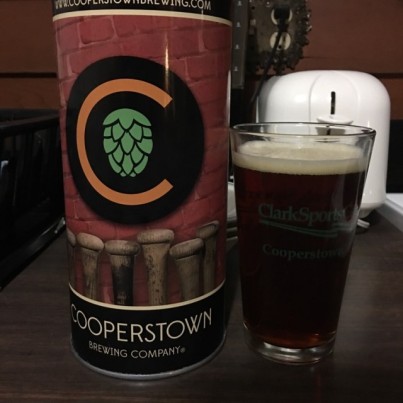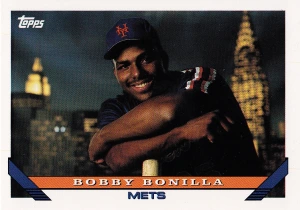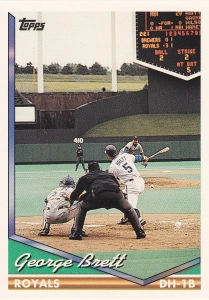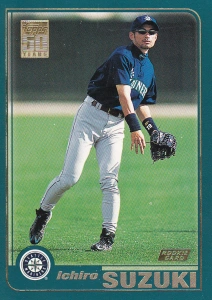I caught up with almost all of my completed insert set posts. I didn’t plan on getting into a hole of 40-50 sets, but I did and now I’m through almost all of it. Now onto the really fun stuff – I’ve finished off 2 base Topps sets, which is awesome.
For this one, I haven’t finished off the “Master Set” yet – though I’m only a few insert cards away from that. So it’s just the “complete set” post for now. This is 1998 Topps.
Info about my set:
This slideshow requires JavaScript.
How I put the set together:
- 265 cards from the series 1 hobby box
- 188 cards from the series 2 hobby box
- 48 cards from trades
- 2 cards from eBay
Card that completed my set: #160 – Derek Jeter (from an eBay lot)

I got this and Vinny Castilla’s card back as part of eBay lot in September of last year – so almost a year ago!
Set composition: 503 cards (433 individual ML player cards*, 16 Prospects, 10 Expansion Team, 12 Draft Picks, 4 Checklists, 1 Tribute, 10 Season Highlights, 7 World Series Highlights, 10 Interleague Play)
*The 433 individual player cards include 10 All-Star Rookies
Representation of ’97 MLB season:
8 of the Expansion Team cards are dual-player, and the Prospect cards all have 3 players on them. 9 players were in the set twice after being shown with their new team in series 2. Doing the math, that’s 490 players represented in the set (433+48+18-9).
Of the 48 guys in the Prospect cards, 8 played in MLB in 1997 – meaning 40 didn’t. The 2 guys on the single-player Expansion Team cards – Brian Anderson and Tony Saunders – played MLB in 1997 – but the other 16 didn’t. 3 more guys had regular cards but didn’t play in 1997 (all were expansion players). That leaves 431 players who played in the majors.
The 431 players represent 38.4% out of the 1,123 players who played in MLB in 1997.
Earliest active player from this set: #21 – Roberto Clemente, #200 – Dennis Eckersley (active players)
Just like 1997 Topps, there are two answers to this. And just like 1997 Topps, Eck is the earliest active player. He made his debut on April 12, 1975, pitching the last 1.2 innings of a 1-run Cleveland loss to Milwaukee. Eckersley beats out Denny Martinez, who debuted in 1976.

Clemente is the earliest (and only) retired player – making his debut on April 17, 1955.

Last active player from this set:
UPDATED THIS POST A FEW YEARS LATER:
#254 – Adrian Beltre
Both Bartolo Colon and Beltre played through the end of the 2018 season on the Texas Rangers, but Beltre technically played at a later date. Then 45 – Colon’s last start was September 5th – a game which he lost to finish with a 7-12 record (247-188 for his career), and his last game was an inauspicious relief appearance of a 13-0 loss to Seattle where he gave up 4 runs.
Beltre played in game 162 for the Mariners that year on September 30th. He went 1-for-2 with a single before being replaced after his 2nd at bat (a deep fly ball out against Roenis Elias).
Originally:
#254 – Adrian Beltre, #257 – David Ortiz, #504 – Alex Rodriguez, #360 – Bartolo Colon (all still active)

That’s quite a list. Bartolo was the only one of these guys with a card in 1997, so he’s joined by these 3 in 1998 (for now). A-Rod got his first Topps card in 1998 after not signing a contract with the company. Beltre and Ortiz are in the prospect set. It will be interesting to see who keeps going. Ortiz has said he’s going to retire, but the other 3 plan to play next year if possible.
Player with the most cards in the set: 5 players with 3 cards:
Matt Williams is in the World Series subset and has 2 regular cards. Gary Sheffield has cards in the World Series and Interleague subsets, Juan Gonzalez has a card in both interleague subsets, and Nomar Garciaparra and Tino Martinez were in the Season Highlight and Interleague subsets (in addition to their regular card).
The other 4 guys have an Interleague and is basically only 1 subset, with 10 season highlights cards.
Matt Williams – #12, #439, #280 (World Series)

Gary Sheffield – #166, #279 (World Series), #483 (Interleague Preview)

Tino Martinez – #284, #269 (Season Highlight), #483 (Interleague Preview)

Nomar Garciaparra – #335, #268 (Season Highlight), #481 (Interleague Preview)

Juan Gonzalez – #30, #273(Interleague Highlight), #482 (Interleague Preview)

First Card and the Hundreds: #1 – Tony Gwynn, #100 – Mike Piazza, #200 – Dennis Eckersley, #300 – Roger Clemens, #400 – Delino DeShields, #500 – Dustin Carr / Luis Cruz EXP

Highest book value: #257 – David Ortiz / Richie Sexson / Daryle Ward

The first Topps card for Ortiz slightly outpaces the A-Rod first Topps card below. According to Beckett.
Most notable card: #504 – Alex Rodriguez

After refusing to sign a deal with Topps for the first 4-5 years of his career, A-Rod was a late addition and Topps snuck him in as the last card in the set.
Best card (my opinion): #146 – Jose Guillen

Really cool card with Clemente’s statue in the background. It goes particularly well because Clemente was the “retired player du jour” honored in the set. Guillen is from the Dominican Republic, whereas Clemente was from Puerto Rico. But the Caribbean connection is cool
Second best card (also my opinion): #287 – Brian Jordan

I had a tough time picking these top few cards. I was between the Guillen card above, this card and the A-Rod card, which I feel is pretty high on the iconic scale. I just love this card – Jordan hadn’t played football in a long time at this point, but it’s indicative of the creativity in some of the shots for this set. For “best card” – I had to put the Guillen above because of the Clemente factor. But I think this is a better/cooler pose in and of itself.
Best subset card: #479 – Ken Griffey Jr. / Mike Piazza INTP
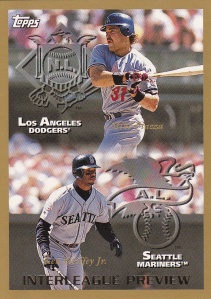
The two guys who just went into the HOF together. I was just there – and one thing that was cool was that Griffey and Piazza had incredible chemistry together. Was really fun – I’m naturally a huge Griffey fan but I came away a Piazza fan after going to Cooperstown last month.
Favorite action photo: #79 – Kevin Polcovich

There aren’t a ton of really great action shots in this set, but I got it down to two cards I was considering for this. Todd Helton’s card was the one that didn’t make the cut. Helton’s card features him following through on a swing on a day game. The shadow effects are really cool in the batters box. But this card of Polcovich – whose career was certainly forgettable compared to Helton’s – shows him levitating over a cloud of dust, after trying to turn a DP!
Favorite non-action photo: #287 – Brian Jordan

As mentioned above – I think if you consider the pose alone, this card is a bit cooler than the Clemente card.
My Favorite Reds card: #240 – Pete Rose Jr.

The only way a Pete Rose could get into a Topps set since 1989. I also really like the Barry Larkin card.
Other Notable Cards: Here’s some of the other cards I considered for some of the “accolades” up above.





